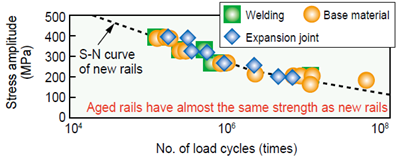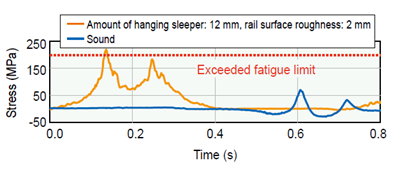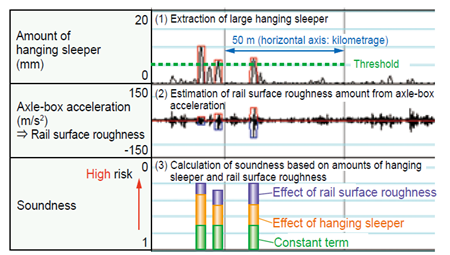12. Extension of Rail Replacement Cycles Considering Fatigue/Soundness
Although rail replacement cycles are set based on the fatigue test results targeting bending fatigue at the base of rails, rails that remain in sound condition are considered to have the potential for much longer service life.
To address this, both fatigue tests of actual rails and rotating bending fatigue tests with 500 million load cycles, equivalent to approximately 5 billion passing tonnages, were conducted on aged rails including welded joints, non-welded rail sections, and expansion joints that had reached approximately 1 billion passing tonnages, which is the current replacement threshold. The results showed minimal reduction in fatigue strength compared to new rails (Figure 1), suggesting that continued use beyond 1 billion passing tonnages is feasible and that fixed replacement cycles could potentially be eliminated.
On the other hand, fatigue damage at the base of rails can occur before reaching the replacement cycle in areas where hanging sleepers or localized irregularities on the top surface of rails are observed. Stress measurements conducted at such locations, along with numerical analysis simulating track conditions, revealed that the stress generated in the rail during train passage can reach several times that of those in sound conditions, exceeding the fatigue limit and causing damage (Figure 2).
Based on these findings, we proposed a method for quantitatively evaluating the possibility of rail failure by estimating fatigue due to stress through numerical analysis, using the amount of hanging sleepers and rail surface roughness calculated from track measurement data. This method was implemented in the LABOCS track maintenance management database system (Figures 3 and 4).
Other Contents
- 9. Design Method for Post-installed Anchor Joint Members in the Reconstruction of Concrete Structures
- 10. Reinforcement Method for Preventing Fatigue Cracks at Steel Girder Support Sections
- 11. Method for Identifying Potentially Critical Locations of Loose Bearing Based on On-board-measured Track Geometry
- 12. Extension of Rail Replacement Cycles Considering Fatigue/Soundness
- 13. Support Method for Extending Inspection Periods Based on Statistical Analysis of Equipment Inspection Records
- 14. Automated Visual Inspection System for Vehicle Underbody
- 15. Autonomous Train Operation System
- 16. General Purpose Real-time Algorithm for Generating Driving Curves for Driver Advisory System
- 17. Method for Updating On-board Databases Using Public Communication Networks
- 18. Labor-saving for Generating Crew Schedule to Enable Workforce Efficiency and Reduce Labor Burden
- 9. Design Method for Post-installed Anchor Joint Members in the Reconstruction of Concrete Structures
- 10. Reinforcement Method for Preventing Fatigue Cracks at Steel Girder Support Sections
- 11. Method for Identifying Potentially Critical Locations of Loose Bearing Based on On-board-measured Track Geometry
- 12. Extension of Rail Replacement Cycles Considering Fatigue/Soundness
- 13. Support Method for Extending Inspection Periods Based on Statistical Analysis of Equipment Inspection Records
- 14. Automated Visual Inspection System for Vehicle Underbody
- 15. Autonomous Train Operation System
- 16. General Purpose Real-time Algorithm for Generating Driving Curves for Driver Advisory System
- 17. Method for Updating On-board Databases Using Public Communication Networks
- 18. Labor-saving for Generating Crew Schedule to Enable Workforce Efficiency and Reduce Labor Burden




